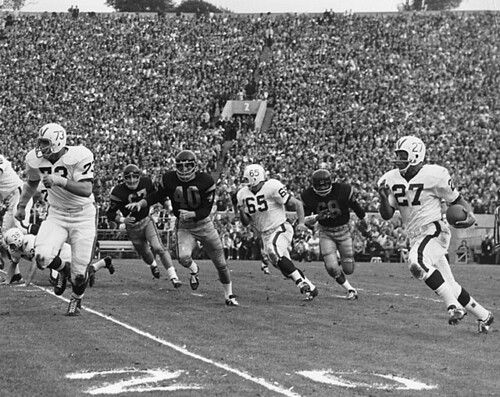Rose Bowl fever continues here on campus in Madison. Curious about the history of the Rose Bowl and construction of the stadium itself, I visited the Rose Bowl Stadium's official website. There, I found they have a great feature--"154 Facts About the Rose Bowl Stadium"--summarizing important dates in the stadium's history.
Particularly interesting, I thought, is how over the course of the 88 years since it was built you can see how not only the capacity has changed/expanded but also how the facility has been modified to meet the needs for accessibility, earthquake safety, modernization and more. Also available on the website are plans for further proposed improvements for "The Next 100 years."
Below are some of the construction/renovation-related highlights. Visit the Rose Bowl Stadium website for the complete list of "154 Facts."
1922 Construction of the horseshoe shaped stadium is completed with a seating capacity of 57,000. Designed by Myron Hunt, the stadium cost $272,198.
1922 The Tournament of Roses Association built the Bowl in the Arroyo, a ravine of parkland and natural vegetation on the west side of Pasadena.
1923 The stadium is named "The Rose Bowl" and is dedicated hosting its first college football game.
1928 Rose Bowl Stadium enlarged by 19,000 seats, increasing seating capacity to 76,000.
1931 Wooden sections of the Rose Bowl are removed and replaced with reinforced concrete. The addition of 10,000 seats increased total capacity to 83,000.
1937 Seating is increased to 87,677.
1949 Stadium is enlarged to seat 94,410 - $335,000 improvement.
1950 Fourth expansion increased capacity to 100,983. The Rose Bowl Game becomes the first bowl game to have 100,000 spectators in attendance.
1969 Wooden benches are replaced with aluminum seating.
1982 An eight-year project to add earthquake reinforcements to the stadium structure begins. Locker rooms are again remodeled, a new sound system is installed, and parking areas are also improved.
1991 Tournament of Roses Association accepts the city's request to renovate the press box, tripling capacity to more than 1,000.
1992 Construction completed on $11.5 million three-level structure at the Rose Bowl providing state-of-the-art facilities for both news media and spectators in the Executive and Club Suites. The seating capacity was increased form 330 to 1,200.
1993 The Rose Bowl is designated as an engineering landmark by the American Society of Civil Engineers. After many renovations, The Rose Bowl seating capacity is 104,594 people.
1993 $2 million renovation of the Rose Bowl is a gift from World Cup USA 1994 Inc. to the City of Pasadena. The field is widened to 224 feet and 345 feet long. Permanent ramps are installed for the disabled. Capacity - 100,184
1996 The Rose Bowl undergoes a $21.5 million renovation including a new sound system, scoreboards, video board, elevator with field access and restrooms.
1997 Disabled access increased. Seating capacity reduced to 98,636.
2007 In August 2007, a 40,000 square foot state of the art new locker room and media center space were added.
The Wisconsin Badgers will meet the TCU Horned Frogs in the 97th Rose Bowl Game on January 1, 2011 at 4:10 pm CT.
The photo above is from the Badgers' 1963 Rose Bowl Game appearance, featuring "Lou Holland of the University of Wisconsin--Madison Badgers running around the end." Image courtesy of University of Wisconsin Digital Collections, via Flickr. Also, be sure to check out their amazing series of football team photos from as far back as 1890!
On Wisconsin!







No comments:
Post a Comment